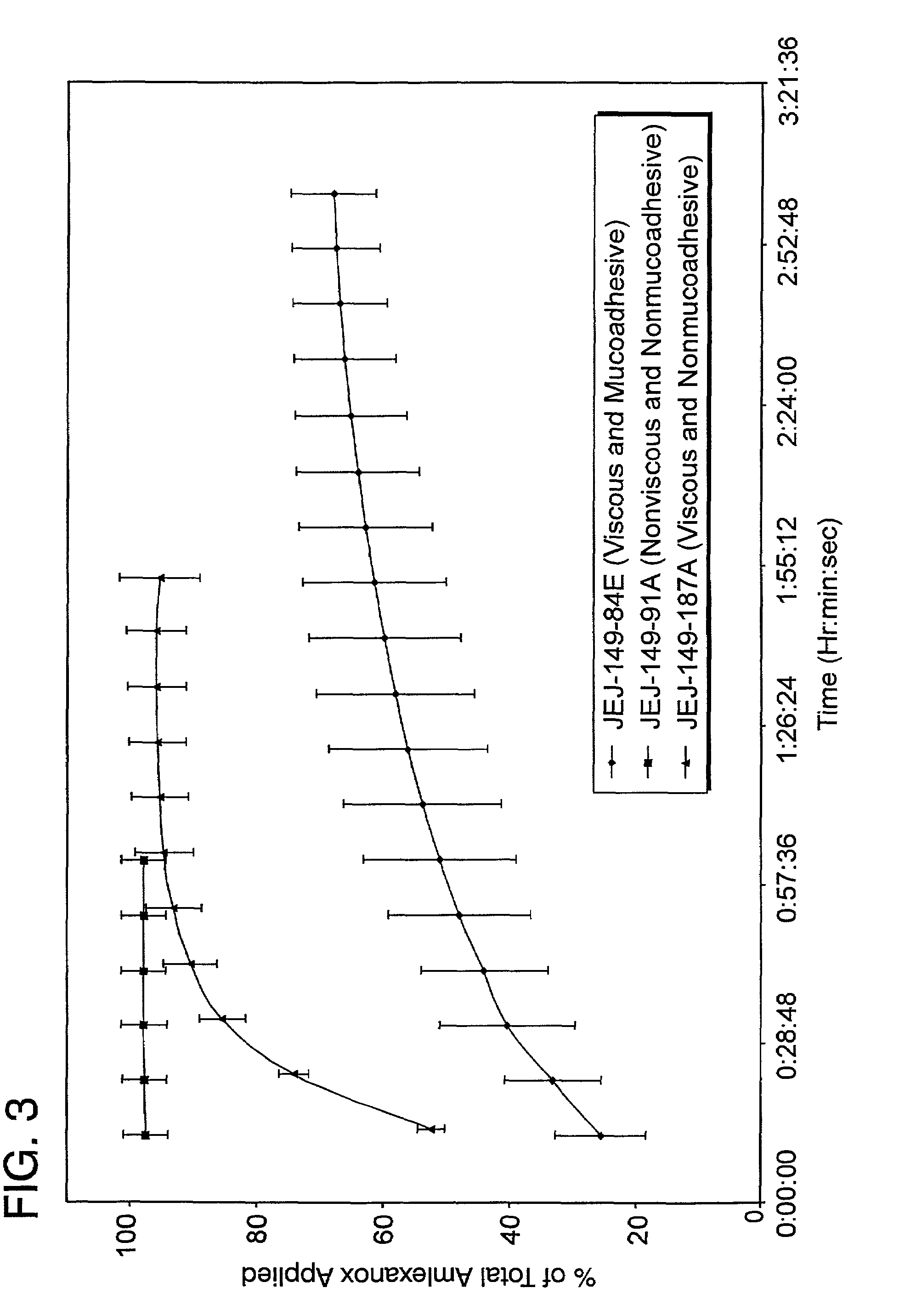Liquid formulations for the prevention and treatment of mucosal diseases and disorders
a liquid formulation and mucosal disease technology, applied in the field of stable, viscose, mucosal disease liquid formulations, can solve the problems of limiting the long-term use at therapeutic doses, urinary tract toxicity, severe pain, etc., to prevent or treat mucosal disease, reduce viscosity, and prevent or treat mucosal disorders.
- Summary
- Abstract
- Description
- Claims
- Application Information
AI Technical Summary
Benefits of technology
Problems solved by technology
Method used
Image
Examples
example 1
Preparation of Viscous, Mucoadhesive Aqueous Composition
[0114]A viscous, mucoadhesive aqueous solution was formulated by adding Carbopol® 971P NF to water using an appropriate mixing apparatus (Master Servodyne® mixer with high-lift blade rotating at 200-300 rpm) to give a clear solution. An aqueous solution of potassium hydroxide was added with stirring to give a clear gel. An aqueous solution of potassium hydroxide, citric acid, saccharin sodium, phosphoric acid and glycerin was added with stirring to give a clear solution. A solution of benzyl alcohol and polysorbate 60 was added with stirring to give a clear solution. The pH was adjusted to 7.0-7.8 with an aqueous solution of phosphoric acid. The resulting product was mixed further for 30 minutes.
[0115]The formulation of the product is set out, below in Table 1:
[0116]
TABLE 1IngredientsWeight Percentpurified water90.6810% potassium hydroxidec.a. 4.6benzyl alcohol1.50polysorbate 600.05Carbopol ® 971P0.350.5% phosphoric acidc.a. 5....
example 2
Preparation of Viscous, Mucoadhesive Aqueous Composition Containing Amlexanox
[0117]The method set out in Example 1 was followed to provide a viscous, mucoadhesive aqueous composition of the following formula shown in Table 2:
[0118]
TABLE 2IngredientsWeight Percentpurified water91.21potassium hydroxide0.60benzyl alcohol1.50polysorbate 600.05Carbopol ® 971P0.35phosphoric acid0.13citric acid0.05saccharin sodium0.40amlexanox0.50Glycerin5.20
example 3
High Performance Liquid Chromatographic Assay for the Amlexanox
[0119]The following HPLC parameters were employed in performing an assaying for amlexanox:[0120]Phenomenex, Prodigy, 5 Φm ODS (2), 150 mm×4.6 mm[0121]Mobile Phase: 25% THF / 75% 10 mM phosphate buffer, pH 8.0[0122]Flow Rate: 1.0 mL / min[0123]Injection Volume: 10 ΦL[0124]Detector: UV@244 nm
PUM
| Property | Measurement | Unit |
|---|---|---|
| zero shear viscosity | aaaaa | aaaaa |
| zero shear viscosity | aaaaa | aaaaa |
| zero shear viscosity | aaaaa | aaaaa |
Abstract
Description
Claims
Application Information
 Login to View More
Login to View More - R&D
- Intellectual Property
- Life Sciences
- Materials
- Tech Scout
- Unparalleled Data Quality
- Higher Quality Content
- 60% Fewer Hallucinations
Browse by: Latest US Patents, China's latest patents, Technical Efficacy Thesaurus, Application Domain, Technology Topic, Popular Technical Reports.
© 2025 PatSnap. All rights reserved.Legal|Privacy policy|Modern Slavery Act Transparency Statement|Sitemap|About US| Contact US: help@patsnap.com



